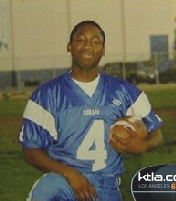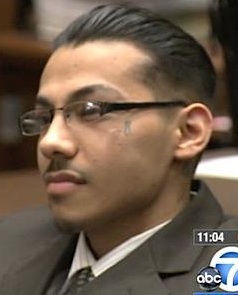

05/16/2012

In Los Angeles, the illegal alien killer of high-school football star Jamiel Shaw (pictured at right) was found guilty of first-degree murder last Wednesday. This week the court has entered the penalty phase to determine whether Mexican gangster Pedro Espinoza will get the death penalty.
Information about the killer is now being revealed that was kept from jurors during the trial, and we learn that Espinoza was a particularly violent character in jail where he acted as a gang enforcer. News reports say he was the aggressor in eight incidents while he was incarcerated, including attacks on other inmates. Plus he was similarly berserk in juvenile detention.
Espinoza’s vicious jail behavior makes authorities’ release of him even more difficult to understand. He was clearly a very dangerous man, yet he was not deported out of America but was allowed to walk free on Los Angeles streets. It was only 28 hours between release and the murder of Jamiel Shaw. Given his previous behavior, that fact is not surprising.
Clearly public safety means nothing in the sanctuary city of Los Angeles if it interferes with the lifestyles of illegal alien criminals.
You can hear more details about Espinoza from the trial penalty phase on the John and Ken radio show, including remarks from Jamiel Shaw Sr.
As another measure of Espinoza’s crazy violence, during the main part of the trial, Culver City detective Bryan Thompson described how Espinoza tried to fight him in the police station.
Below, illegal alien gangster Pedro Espinoza in court.

Penalty phase begins for gang member convicted of killing Jamiel Shaw, Wave Wire Services, May 15 2012
A prosecutor urged jurors Tuesday to recommend a death sentence for a gang member who gunned down a standout Los Angeles High School football player he mistook for a gang rival, citing a history of violence dating back to the defendant’s teen years while he was in juvenile camp.
Defense attorney M. David Houchin countered that his 23-year-old client, Pedro Espinoza, did not get any of the accolades that the 17-year-old victim, Jamiel Shaw Jr., received throughout his life.
“The mirror image is an opposite image when you look at Mr. Shaw,” Houchin told the Los Angeles Superior Court jury, which is being asked to recommend whether the admitted gang member should be sentenced to death or life in prison without the possibility of parole for Shaw’s March 2, 2008, shooting death.
The panel deliberated about four hours before convicting Espinoza May 9 of first-degree murder and finding true the special circumstance allegation that Shaw’s slaying was carried out to further the activities of a criminal street gang.
The victim was shot twice — once in the abdomen and once in the head — only yards from his home in Arlington Heights. Prosecutors said the teen had been walking home carrying a red Spider-Man backpack that made Espinoza perceive him as a gang rival.
In her opening statement in the trial’s penalty phase, Deputy District Attorney Allyson Ostrowski told jurors that they will hear about Shaw’s “promise as a football player,” including being named most valuable player and being looked at by universities such as Stanford and Rutgers.
Jurors will also hear about who Espinoza is, including gang-related incidents in which he was the aggressor while in juvenile camps, along with eight incidents in the Men’s Central Jail that included attacks on other inmates and possession of jailmade weapons after he was arrested in connection with Shaw’s killing, Ostrowski said.
She said the prosecution will ask jurors to recommend “the maximum sentence … because his crimes and his history require it.”
Espinoza’s attorney countered, “Any, any reason, any individual juror may have, be it compassion, be it mercy, anything … can tell you in your heart that the appropriate penalty is life in prison without the possibility of parole.”
Deputy Probation Officer Carl Patton testified that Espinoza jumped into a fight involving a rival gang member who was outnumbered and that he kicked the other teen in the face after being handcuffed during an April 12, 2006, earthquake drill at a juvenile camp.
The deputy probation officer said that on another occasion, he called Espinoza into a room with chairs of various colors and asked him why he would sit in the blue chair.
“He said, ‘Blue’s our color,’” Patton testified, noting that he asked the teen what if sitting in a blue chair meant he was going to death row.
“How did the defendant respond?” Ostrowski asked.
“He said he was down for death row,” Patton said, noting that he was surprised by the teen’s response.
“I said, ‘Do you know what type of crime you have to commit to get to death row?’ He said, ‘Killing,”‘ the deputy probation officer said.
Los Angeles County sheriff’s Deputy Albert Murad testified that he was escorting inmates including Espinoza back to the “high power module” at the Men’s Central Jail in November 2008 when Espinoza rushed forward and attacked another prisoner.
“He was using the chains as a weapon, striking him in the face,” Murad told jurors.
Another sheriff’s deputy, Chris Hernandez, testified that Espinoza stuck his arm through a food tray slot in his cell and used a jail-made weapon to slash another inmate as he walked by in June 2009 before flushing the weapon down a toilet in his cell. Espinoza later said the inmate “had it coming” and had been “running his mouth since he got here,” Hernandez said.
Other prosecution witnesses testified that Espinoza was also involved in gang-related run-ins in October 2005, February 2006 and on April 1, 2006.
“He seemed unremorseful considering the history I have working with juveniles …,” Probation Department employee Raymond Chavez said of Espinoza’s demeanor following the Oct. 6, 2005, incident in which he “literally jumped over” a table during a classroom session and began punching another teen.
“This gentleman was poker-faced as though it was second nature,” Chavez said.
Jurors heard from Shaw’s varsity football coach at Los Angeles High School, who called the victim “a special athlete.”“Jamiel was a star from the very beginning,” Hardy Williams said, noting that Shaw had “speed” and “moves” that set him apart even as a ninth-grader.
Jurors were shown a video compilation that included footage from the games in which Shaw played and the numerous honors he was awarded. Williams said, “It was hard to watch that,” noting that he had expected “the sky is the limit” for what would have been Shaw’s senior year.
The players and the whole school were “torn up” about his murder, Williams said. He noted that Shaw’s varsity number — 4 — has been retired and won’t be used again.
Jurors are also expected to hear from Shaw’s parents, who have campaigned for a law that would enable police to arrest undocumented-immigrant gang members and hand them over to federal authorities. Espinoza had just been released from jail following his arrest for brandishing a firearm.